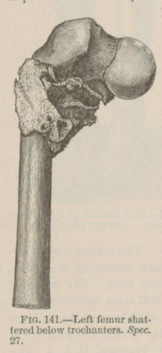Title: Northrup, J.
Source text: The Medical and Surgical History of the War of the Rebellion. (1861-65.), Part 3, Volume 2 (Washington, DC: Government Printing Office, 1883), 184.
Civil War Washington ID: med.d2e8442
TEI/XML: med.d2e8442.xml
CASE 374.—Private J. Northrup, Co. K, 77th New York, aged 21 years, was wounded before Yorktown, April 29, 1862, and entered the Douglas Hospital, Washington, May 15th. Assistant Surgeon W. Webster, U. S. A., forwarded the specimen (FIG. 141), and recorded the following history: "The wound was caused by a conoidal ball, which entered on the outer side of the lower portion of the upper third of the left thigh, and was extracted through the gluteus maximus muscle on a level with and two inches from the anus, same side. The missile produced a compound fracture of the femur at the upper third and shortened the limb to the extent of two inches. On admission, the patient, who was of robust and healthy appearance, had considerable fever and constipation of the bowels. There was extensive swelling of the integuments, and he was suffering acute pain. Vedder's long splint was applied, and extension from the ankle and counter-extension by a perineal band was made. By these means the limb was lengthened one inch and retained in that position. The acute pain rendered any further extension impracticable. The patient was ordered to take one-half ounce of castor oil, and sulphate of morphia at night to relieve the pain. May 18th, the wound has been dressed with poultices of flaxseed meal; the swelling has some what subsided and there is no fever. The pain continues, and to relieve it and promote sleep a mixture of two drachms of elixir of opium and one ounce of camphor water is given in two doses every evening. June 2d, the discharge has ceased and the external wound is nearly closed. There are some signs of union and of the deposition of abundant provisional callus. June 10th, the splint was removed; the shortening of the limb now amounts to three inches. June 16th, the patient was this morning attacked with chills and the initiatory symptoms of fever, a frequent and very weak pulse and red tongue, also great tenderness in the epigastric region, with frequent vomiting. The above symptoms continued without intermission until terminated in death, at 11 o'clock P. M., on June 18, 1862. The autopsy, ten hours after death, confirmed the previous diagnosis of acute gastro-enteritis. The coats of the stomach were found to be intensely congested, with disorganization of the mucous membrane, which appeared to be greatest about the greater curvature of the stomach. The fracture was found firmly consolidated, with abundant deposition of provisional callus." The specimen consists of the upper half of the fractured femur, showing partial union at right angles and the shaft roughened by the action of pus, also callus somewhat copiously thrown out and entangling the fragments, but the inner surfaces being carious.
